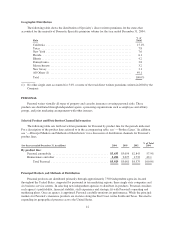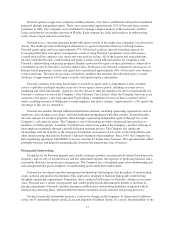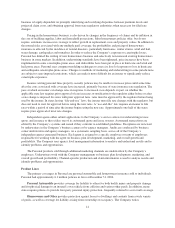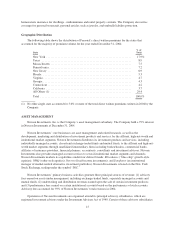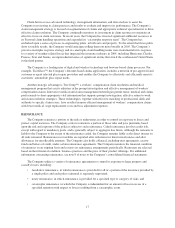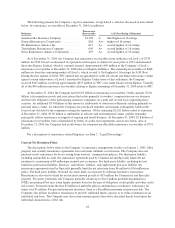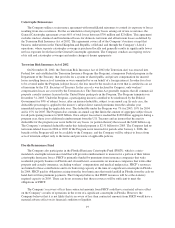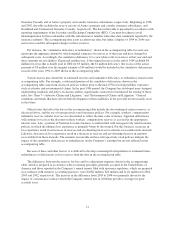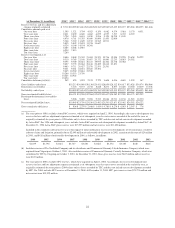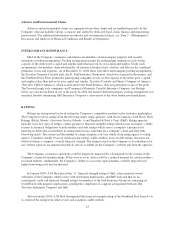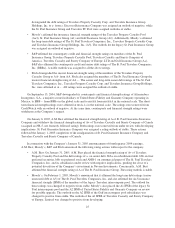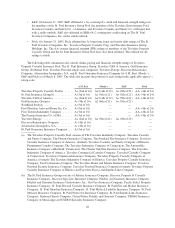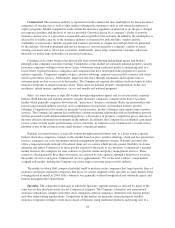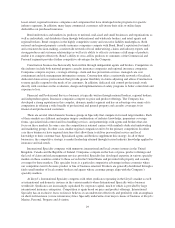Travelers 2004 Annual Report Download - page 31
Download and view the complete annual report
Please find page 31 of the 2004 Travelers annual report below. You can navigate through the pages in the report by either clicking on the pages listed below, or by using the keyword search tool below to find specific information within the annual report.Catastrophe Reinsurance
The Company utilizes a reinsurance agreement with nonaffiliated reinsurers to control its exposure to losses
resulting from one occurrence. For the accumulation of net property losses arising out of one occurrence, the
General Catastrophe agreement covers 60% of total losses between $750 million and $2 billion. This agreement
excludes nuclear, chemical and biochemical losses for domestic terrorism and all terrorism losses as defined by
the Terrorism Risk Insurance Act of 2002. This agreement covers all of the Company’s business except that
business underwritten in the United Kingdom and Republic of Ireland, and through the Company’s Lloyd’s
operations, where separate catastrophe coverage is purchased locally and generally results in significantly lower
net loss exposure levels than in the General Catastrophe agreement. The Company conducts an ongoing review
of its risk and catastrophe coverages and makes changes it deems appropriate.
Terrorism Risk Insurance Act of 2002
On November 26, 2002, the Terrorism Risk Insurance Act of 2002 (the Terrorism Act) was enacted into
Federal law and established the Terrorism Insurance Program (the Program), a temporary Federal program in the
Department of the Treasury, that provides for a system of shared public and private compensation for insured
losses resulting from acts of terrorism or war committed by or on behalf of a foreign interest. In order for a loss
to be covered under the Program (subject losses), the loss must be the result of an event that is certified as an act
of terrorism by the U.S. Secretary of Treasury. In the case of a war declared by Congress, only workers’
compensation losses are covered by the Terrorism Act. The Terrorism Act generally requires that all commercial
property casualty insurers licensed in the United States participate in the Program. The Program terminates on
December 31, 2005. Under the Program, a participating insurer is entitled to be reimbursed by the Federal
Government for 90% of subject losses, after an insurer deductible, subject to an annual cap. In each case, the
deductible percentage is applied to the insurer’s subject direct earned premiums from the calendar year
immediately preceding the applicable year. The deductible under the Program was 7% for 2003, 10% for 2004
and is 15% for 2005. The Program also contains an annual cap that limits the amount of aggregate subject losses
for all participating insurers to $100 billion. Once subject losses have reached the $100 billion aggregate during a
program year, there is no additional reimbursement from the U.S. Treasury and an insurer that has met its
deductible for the program year is not liable for any losses (or portion thereof) that exceed the $100 billion cap.
The Company’s estimated deductible under this federal program is $2.51 billion for 2005. The Company had no
terrorism-related losses in 2004 or 2003. If the Program is not renewed for periods after January 1, 2006, the
benefits of the Program will not be available to the Company, and the Company will be subject to losses from
acts of terrorism subject only to the terms and provisions of applicable policies.
Florida Reinsurance Fund
The Company also participates in the Florida Hurricane Catastrophe Fund (FHCF), which is a state-
mandated catastrophe reinsurance fund that will provide reimbursement to insurers for a portion of their future
catastrophic hurricane losses. FHCF is primarily funded by premiums from insurance companies that write
residential property business in Florida and, if insufficient, assessments on insurance companies that write other
property and casualty insurance, excluding workers’ compensation and medical malpractice. FHCF’s resources
are limited to these contributions and to its borrowing capacity at the time of a significant catastrophe in Florida.
In 2004, FHCF paid its obligations arising from the four hurricanes that made landfall in Florida from the cash on
hand derived from premium payments. The Company believes that FHCF resources will be at the statutory
required capacity in 2005. There can be no assurance that these resources will be sufficient to meet the
obligations of FHCF.
The Company’s recovery of less than contracted amounts from FHCF could have a material adverse effect
on the Company’s results of operations in the event of a significant catastrophe in Florida. However, the
Company believes that it is not likely that its recovery of less than contracted amounts from FHCF would have a
material adverse effect on its financial condition or liquidity.
19





